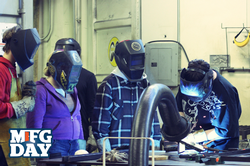
October 7th is Manufacturing Day
October 7 marks the fifth annual Manufacturing DaySM when thousands of manufacturers will again host students, teachers, parents, job seekers and community leaders at open houses, plant tours and educational sessions to showcase modern manufacturing technology and the cool jobs available. It is a chance for students to see the diverse career options that are innovative, impactful and durable. As the old idiom goes, “Seeing is believing,’ and that is the guiding principle behind Manufacturing Day. It was created in response to a dire need in America: The industry today faces a major shortage of skilled workers. An estimated two million manufacturing jobs will go unfilled over the next decade due to companies’ inability to find talent with the required skills. Several leading industry organizations determined five years ago the best way to combat this malady and reverse negative misperceptions people may have about manufacturing jobs and careers is to literally show “up close and personal” the exciting kind of work that takes place in plants across the U.S. Participation grows every year. In 2015, more than 2,600 live events were held attended by more than 225,000 students and 55,000 parents, educators, job seekers and other influentials. Impressive numbers, without a doubt. But, did “seeing” actually make these groups “believers”?
Data Shows Theory Works
Research reveals the theory behind Manufacturing Day works. For the first time, participants were polled about their experience. A new Deloitte perception survey developed in collaboration with The Manufacturing Institute was distributed to the more than 2,500 manufacturing hosts to gather data from attendees. The results are dramatic:
- 81 percent of student respondents are more convinced manufacturing provides careers that are both interesting and rewarding
- 71 percent of student respondents are more likely to tell friends, family, parents or colleagues about manufacturing
- 93 percent of educators are more convinced manufacturing provides careers that are interesting and rewarding
- 90 percent of educators indicated they are more likely to encourage students to pursue a career in manufacturing
“These findings significantly reinforce the value of Manufacturing Day,” according to Michelle Drew Rodriguez, manufacturing leader, Center for Industry Insights, at Deloitte. “For those truly exposed to modern day manufacturing, perceptions do change and, based on that, we will move the needle to better fill the skills gap that challenges so many companies today.” Drew Rodriguez explained that as a professional services firm, Deloitte talks to senior level executives every day and for them finding top talent is a top-of-mind, critical issue. It’s one reason why Deloitte has partnered with The Manufacturing Institute for a number of years to help tackle the problem.
Skills Gap Studies Offer Insights
One of those joint initiatives is Deloitte’s Skills Gap studies. The current report highlights the impact of the skills gap and offers recommendations on how to help remedy it, which provides further credence to the benefits gained from Manufacturing Day programs. For example, 82 percent of executives responding to the Skills Gap survey indicate they believe the gap will impact their ability to meet customer demand. More than three-quarters (78 percent) believe it will impact their ability to implement new technologies and increase productivity. Large numbers also report the lack of skilled workers hurts the ability to provide effective customer service (cited by 69 percent) and decreases the ability to innovate and develop new products (62 percent). The Skills Gap study also addresses the industry perception problem. Citing the Public Perception of Manufacturing research The Manufacturing Institute and Deloitte conducted over the years, the report notes that “while Americans consider manufacturing among one of the most important domestic industries for maintaining a strong national economy, they rank it low as a career choice for themselves.” The study continues to say, “Moreover, only 37 percent of respondents indicated they would encourage their children to pursue a manufacturing career.” Yet, here’s the proverbial light at the end of the tunnel. According to the report, “Interestingly, those with high industry familiarity tend to have more favorable perceptions, and they are twice as likely (emphasis added) as those with no familiarity to encourage their children to pursue a manufacturing career.” This data aligns with a study done in collaboration with Skills USA, Educational Research of America, and The Manufacturing Institute, which found that 64 percent of students identified personal experiences as having the greatest influence over their career decisions.
Engagement is Essential
One conclusion the Public Perception report makes is “manufacturers need to engage people through community, educational and government programs in order to improve the perception of the U.S. manufacturing industry.” That statement captures the mission of Manufacturing Day. And, as the results of the survey of participants strongly demonstrate, changing perceptions through this initiative has become a tangible measurement. When we first announced these findings, Carroll Thomas, director of the Manufacturing Extension Partnership, said, “It is powerful to see that our collective efforts are making a difference in educating the public about manufacturing and its rewarding careers, and how manufacturers are connecting with the next generation workforce.” For students participating in Manufacturing Day, seeing really is believing – believing that their futures can be bright with a career in manufacturing.
Here is a link to see how companies are celebrating MFG Day.









